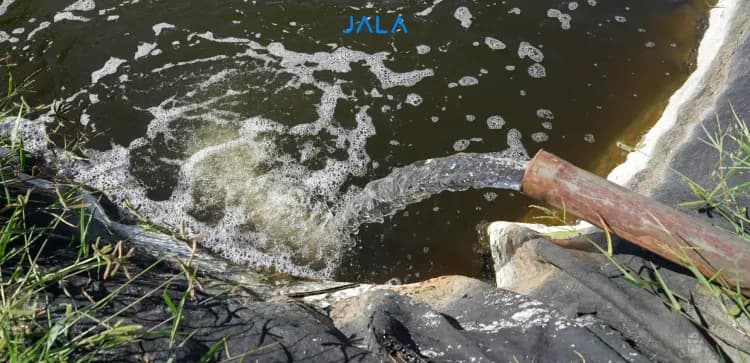
One of the most common issues in Indonesian shrimp cultivation is environmental damage due to the excessive exploitation in lands used for shrimp farms. This causes physical, chemical, and biological environmental degradation, threatening farm productivity. A sustainable, productive, and environmentally friendly technological innovation is thus required. One of the concepts that can be implemented is Integrated Multi-trophic Aquaculture (IMTA).
The IMTA system is a type of cultivation system that combines commodities from several different trophic levels. Every commodity has different roles that benefit one another to maintain the ecosystem. For example, microalgae or seaweed can be used as the main producer, followed by fish and shrimp at the primary consumer level, molluscs as extractive organisms that absorb organic matter, and shrimp as the primary commodity.
IMTA System in Shrimp Cultivation
Conceptually, IMTA combines commodities at different trophic levels. It can help maintain balance in the ecosystem as every species has different roles such as carnivores, herbivores, and biofilters. The IMTA system relies on recycling waste from the cultivation process produced by the main species (shrimp or fish) as an energy and nutrient source for other commodities, resulting in harvestable products while minimizing environmental degradation.
Waste from shrimp and fish feed is utilized by molluscs for their growth while acting as a biofilter which improves the cultivation water quality. Seaweed acts as producers which absorb nutrients from the water, fertilizer, and metabolic waste from the farm biota. That way, water quality is maintained, and the seaweed is able to grow well. The fish also improves water quality by carrying oxygen-containing water currents to supply sufficient dissolved oxygen in the cultivation.
This integrated system can improve shrimp productivity with optimum water quality. This concept is a form of green technology that minimizes waste.
In summary, here are the benefits of an IMTA system:
- Increasing productivity
- Conserving environmental quality
- Minimizing waste
- Increasing product diversity
- Increasing farmer income
- Improving aquaculture sustainability
Implementation of IMTA Technology in Shrimp Cultivation
The first step in IMTA implementation is choosing the cultivation commodity which may be one of the following:
Vannamei Shrimp
The characteristics of vannamei shrimp (Litopenaeus vannamei) that make it beneficial to cultivate are namely: easily cultivated, feed responsive, able to grow well in harsh environmental conditions, high survival rate, and can be cultivated in a moderately high stocking density and relatively shorter cultivation period, or 90-100 days per cycle.
Tilapia
Tilapia fish (Oreochromis niloticus) is a type of fish with high productivity, relatively fast growth rate, and resistance to harsh environmental conditions. Moreover, tilapia consumes omnivorous plankton. Research has shown that tilapia fish is able to inhibit the growth of pathogenic bacteria such as Vibrio spp..
Seaweed
Seaweed is a type of organism that can be utilized at the lowest trophic level due to its ability to use inorganic components for growth.
Mollusca
Mollusca, which include various shells, play a role as biofilters in an IMTA system. Shells can be filter feeders to absorb phytoplanktons, bacteria, fungi, flagellates, and other organic components suspended in water to maintain water quality at an ideal level.
The Result of IMTA System Implementation in Indonesian Shrimp Cultivation
A research conducted by Rejeki et al., 2016 on the IMTA system involves organisms such as milkfish (Chanos chanos), tilapia (O. niloticus), vannamei shrimp (L. vannamei), seaweed (Gracilaria verrucosa), and green mussel (Perna viridis). This system successfully maintains water quality, thus improving natural feed availability to support cultivated organisms' growth rate.
The implementation of the IMTA system involves polyculture cultivation or cultivation with several organisms. It integrates organisms from various trophic levels from producers, and consumers, to filter feeders. This system offers benefits from both ecological and economic perspectives.
Resources:
Biswasa, G., P. Kumara, T. K. Ghoshala, M. Kailasam, D. Dea, A. Berab, B. Mandala, K. Sukumaran, and K.K. Vijayan. Integrated multi-trophic aquaculture (IMTA) outperforms conventional polyculture with respect to environmental remediation, productivity and economic return in brackishwater ponds. Aquaculture.516: 1-8.
Purnamasari, I., D. Purnama, dan M. A. F. Utami. 2017. Pertumbuhan Udang Vaname (Litopenaeus vannamei) di Tambak Intensif. Jurnal Enggano. 2 (1) : 58-67.
Putra, A. dan M. Mulyono. 2023. Implementasi Akuakultur Biru Melalui Sistem IMTA (Integrated Multi-Trophic-Aquaculture). Jurnal Kelautan dan Perikanan Terapan: 117-122.
Rejeki, S., R. S. Ariyati, and L. L. Widowati. (2016). Application of Integrated Multi Trophic Aquaculture Concept in an Abraded Brackish Water Pond. Jurnal Teknologi. 78 (4): 227-232.
SHORT BIOGRAPHY
Nur Setya Wati or Tia resides in Semarang and is currently a student at Diponegoro University, in the Aquaculture Study Program. Tia was born in Rembang on 2 May 2000. She is interested in fishery and marine science, and one of her hobbies is aquascaping.





